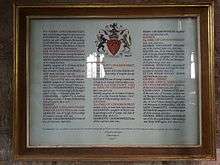George Cholmondeley, 2nd Earl of Cholmondeley
George Cholmondeley, 2nd Earl of Cholmondeley, PC, FRS (1666 – 7 May 1733), styled The Honourable from birth until 1715 and then known as Lord Newborough to 1725, was an English soldier. Cholmondeley was the second son of Robert Cholmondeley, 1st Viscount Cholmondeley, and Elizabeth Cradock. Hugh Cholmondeley, 1st Earl of Cholmondeley, was his elder brother. He was educated at Westminster School and Christ Church, Oxford. Cholmondeley supported the claim of William of Orange and Mary to the English throne and after their accession he was appointed a Groom of the Bedchamber.

Military and political career
In 1690 he commanded the Horse Grenadier Guards at the Battle of the Boyne and two years later he fought at the Battle of Steenkerque. From 1690 to 1695 he represented Newton in the House of Commons. Cholmondeley was promoted to Brigadier-General in 1697, to Major-General in 1702, to Lieutenant-General in 1704 and to General in 1727.
Honours and titles
He was admitted to the Privy Council in 1706 and in 1715 he was raised to the Peerage of Ireland as Baron Newborough, of Newborough in the County of Wexford. One year later he was created Baron Newburgh, of Newburgh in the County of Anglesea, in the Peerage of Great Britain, and in 1725 Cholmondeley succeeded his elder brother as second Earl of Cholmondeley. He also succeeded him as Lord Lieutenant of Cheshire, Anglesey, Caernarvonshire, Denbighshire, Flintshire, Merionetshire and Montgomeryshire, posts he held until his death.
Family
Lord Cholmondeley married Anna Elizabeth van Ruytenburgh (c. 1672 – London, 16 January 1722), daughter of Aelbert Heer van Ruytenburgh (1630–1688) and Wilhelmina Anna van Nassau (1638–1688), around 1701. They had three sons and three daughters. He died in May 1733 and was succeeded in his titles by his eldest son George.
References
- Stephen, Leslie, ed. (1887). . Dictionary of National Biography. 10. London: Smith, Elder & Co.
- Kidd, Charles, Williamson, David (editors). Debrett's Peerage and Baronetage (1990 edition). New York: St Martin's Press, 1990,
- Leigh Rayment's Peerage Pages
- Lundy, Darryl. "FAQ". The Peerage.
| Parliament of England | ||
|---|---|---|
| Preceded by Sir John Chicheley Francis Cholmondeley |
Member of Parliament for Newton 1690–1695 With: Sir John Chicheley 1690–1691 John Bennet 1691–1695 |
Succeeded by Legh Banks Thomas Brotherton |
| Military offices | ||
| New regiment | Captain and Colonel of the 1st Troop Horse Grenadier Guards 1693–1715 |
Succeeded by Lord Lumley |
| Preceded by William Selwyn |
Governor of Gravesend and Tilbury 1702–1725 |
Succeeded by William Tatton |
| Preceded by The Earl of Arran |
Captain and Colonel of the 3rd Troop of Horse Guards 1715–1733 |
Succeeded by The Earl of Albemarle |
| Preceded by The Earl of Cholmondeley |
Governor of Chester 1725–1733 |
Succeeded by The Earl of Cholmondeley |
| Preceded by Thomas Stanwix |
Governor of Kingston-upon-Hull 1725–1732 |
Succeeded by Edward Montagu |
| Preceded by Daniel Harvey |
Governor of Guernsey 1732–1733 |
Succeeded by Richard Sutton |
| Honorary titles | ||
| Preceded by The Earl of Cholmondeley |
Lord-Lieutenant of Cheshire, Anglesey, Caernarvonshire, Flintshire, Merionethshire and Montgomeryshire 1725–1733 |
Succeeded by The Earl of Cholmondeley |
| Vice-Admiral of Cheshire 1725–1733 | ||
| Lord Lieutenant of Denbighshire 1725–1733 |
Succeeded by Sir Robert Salusbury Cotton, Bt | |
| Peerage of England | ||
| Preceded by Hugh Cholmondeley |
Earl of Cholmondeley 1725–1733 |
Succeeded by George Cholmondeley |
| Peerage of Great Britain | ||
| New creation | Baron Newburgh 1716–1733 |
Succeeded by George Cholmondeley |
| Peerage of Ireland | ||
| New creation | Baron Newborough 1715–1733 |
Succeeded by George Cholmondeley |